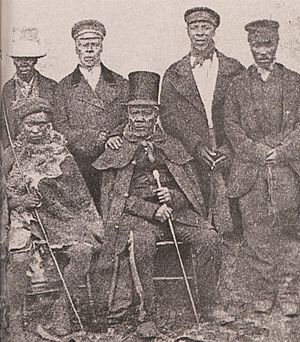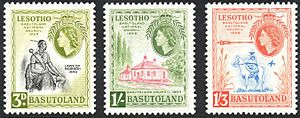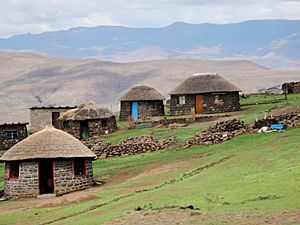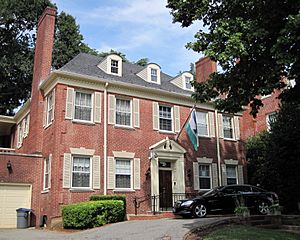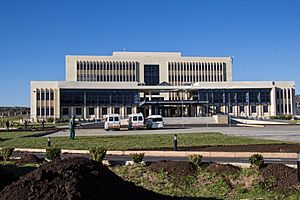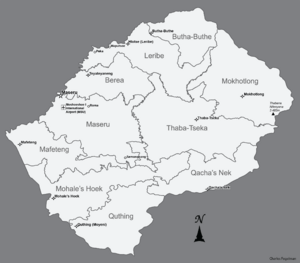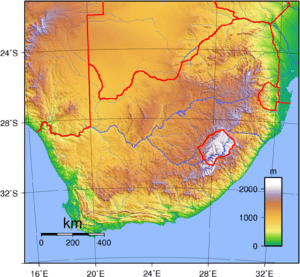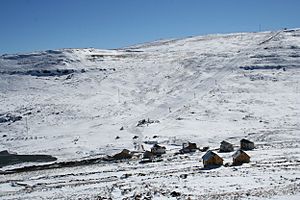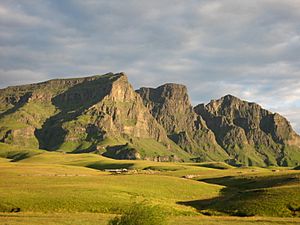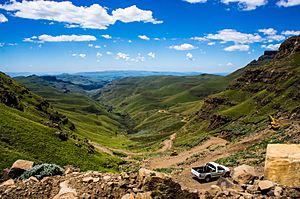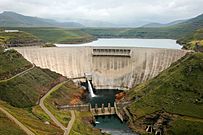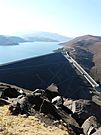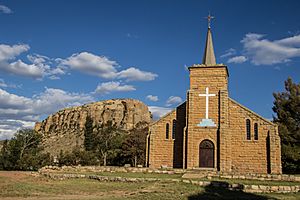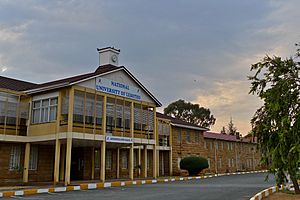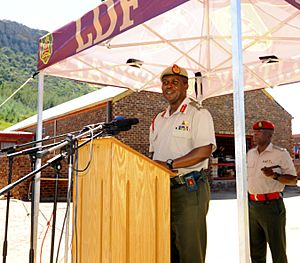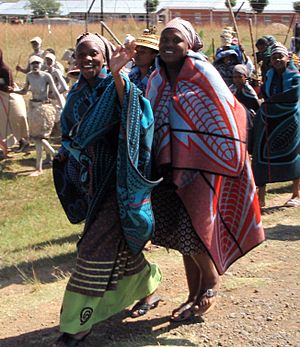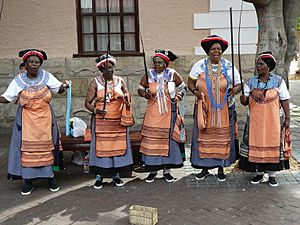Lesotho facts for kids
Quick facts for kids
Kingdom of Lesotho
Naha ea Lesotho (Sotho)
|
|
|---|---|
|
|
|
|
Motto: "Khotso, Pula, Nala"
"Peace, Rain, Prosperity" |
|
|
Anthem: Lesōthō Fatše La Bo-Ntat'a Rōna
("Lesotho, land of our Fathers") |
|
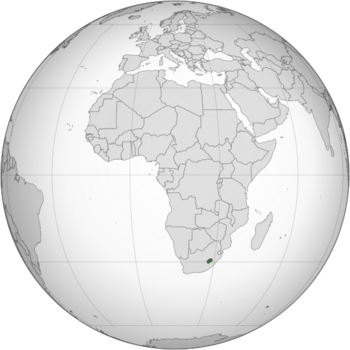
Location of Lesotho (dark green)
|
|
| Capital and largest city
|
Maseru 29°18′54″S 27°29′13″E / 29.31500°S 27.48694°E |
| Official languages |
|
| Ethnic groups
(2020)
|
|
| Religion
(2020)
|
|
| Demonym(s) |
|
| Government | Unitary parliamentary constitutional monarchy |
|
• Monarch
|
Letsie III |
| Sam Matekane | |
| Legislature | Parliament |
| Senate | |
| National Assembly | |
| Independence from the United Kingdom | |
|
• Independence declared
|
4 October 1966 |
| Area | |
|
• Total
|
30,355 km2 (11,720 sq mi) (137th) |
|
• Water (%)
|
negligible |
| Population | |
|
• 2023 estimate
|
2,210,646 (147th) |
|
• Density
|
68.1/km2 (176.4/sq mi) (138th) |
| GDP (PPP) | 2023 estimate |
|
• Total
|
|
|
• Per capita
|
|
| GDP (nominal) | 2023 estimate |
|
• Total
|
|
|
• Per capita
|
|
| Gini (2017) | ▼ 44.9 medium |
| HDI (2022) | low · 168th |
| Currency | Lesotho loti (LSL) South African rand (ZAR) |
| Time zone | UTC+2 (South African Standard Time) |
| Date format | yyyy-mm-dd dd/mm/yyyy |
| Driving side | left |
| Calling code | +266 |
| ISO 3166 code | LS |
| Internet TLD | .ls |
|
|
Lesotho (lə-SOO-too), officially known as the Kingdom of Lesotho, is a country completely surrounded by South Africa. It is a very mountainous country, home to the Maloti Mountains and the highest peaks in Southern Africa. Lesotho covers just over 30,000 square kilometers (11,720 square miles) and has about 2.2 million people. Its capital and largest city is Maseru. The official languages are Sesotho and English.
Lesotho used to be a British colony called Basutoland. It became independent from the United Kingdom on October 4, 1966. Today, it is a fully independent country and a member of the United Nations, the Commonwealth of Nations, and the African Union. The name Lesotho means "land of the Sotho people."
Contents
Lesotho's History
Early Inhabitants and Moshoeshoe I's Rule (1822–1868)
The first people to live in the area that is now Lesotho were the San people. You can still find examples of their rock paintings in the mountains.
Lesotho became a single country under King Moshoeshoe I in 1822. Moshoeshoe was a chief who gathered followers and settled at Butha-Buthe Mountain. He united different groups to resist conflicts happening in the region.
Later, missionaries from France arrived and helped Moshoeshoe I. They developed a writing system for the Sesotho language and printed books. One missionary, Eugène Casalis, helped Moshoeshoe with foreign affairs and getting weapons to protect his people.
Farmers from the Cape Colony (a British territory) started moving into Lesotho's western lands. They claimed the land was empty. Moshoeshoe signed a treaty with the British to protect his territory. There were some battles with the Boers (Dutch settlers) and the British. In 1851, the Basotho army even defeated a British force. After more conflicts, Moshoeshoe asked Queen Victoria of Britain for help. In 1868, Basutoland became a British protectorate, meaning Britain would protect it.
British Rule (1869–1966)
In 1869, the British signed a treaty that set the borders of Basutoland. This made Moshoeshoe's kingdom smaller. The British moved the capital to Maseru. Moshoeshoe I passed away on March 11, 1870, marking the end of the traditional era and the start of British colonial rule.
From 1871 to 1884, Basutoland was managed by the Cape Colony. This led to some unhappiness among the Basotho people, including a conflict known as the Basuto Gun War in 1880–1881.
In 1884, Basutoland became a direct British Crown Colony with Maseru as its capital. It was ruled by a governor, but local chiefs still had power within their communities. In 1905, a railway line was built to connect Maseru to South Africa's railway system.
Independence (1966–Present)
Basutoland gained its independence from the United Kingdom and became the Kingdom of Lesotho in 1966.
After independence, there were some political challenges. In 1970, the ruling party lost the elections, but the Prime Minister, Leabua Jonathan, refused to give up power. He continued to lead the country until 1986, when a military takeover occurred.
The military government gave more power to King Moshoeshoe II, who was previously a ceremonial leader. However, in 1987, the King was asked to leave the country after he wanted more executive powers. His son, Letsie III, became King.
In 1993, the military government handed power back to a democratically elected government. King Moshoeshoe II returned to Lesotho. In 1994, King Letsie III tried to get his father reinstated as head of state. After discussions with other Southern African countries, the elected government was put back in place. King Letsie III then stepped down for his father. Moshoeshoe II died in a road accident in 1996, and Letsie III became King again.
In 1997, the ruling party split. A new party, the Lesotho Congress for Democracy (LCD), was formed and won the elections in 1998. There were some protests and unrest, but eventually, a new electoral system was created to ensure all political parties were represented.
In 2002, elections were held under this new system, and the LCD won again. This time, opposition parties gained more seats, and it was considered a peaceful election.
In 2014, there was an attempted military takeover, which forced the then Prime Minister, Thomas Thabane, to leave the country for a few days. In 2020, Thomas Thabane officially stepped down as prime minister, and Moeketsi Majoro took his place.
Lesotho's Government and Politics
Lesotho is a constitutional monarchy, which means it has a King, but the country is governed by a constitution and elected officials. The Prime Minister is the head of the government and makes most of the decisions. The King of Lesotho is the head of state, but his role is mostly ceremonial. He does not have executive power and cannot actively participate in political activities.
Lesotho's parliament has two parts:
- The National Assembly is the lower house, where elected representatives make laws.
- The Senate is the upper house. It includes 22 principal chiefs who inherit their positions, and 11 members chosen by the King based on the Prime Minister's advice.
The country has an independent court system, including the High Court, the Court of Appeal, and local courts. Judges make rulings, and there are no juries.
Lesotho's constitution protects important rights like freedom of speech, freedom of association, freedom of the press, and freedom of religion.
Foreign Relations
Lesotho is part of several regional groups, like the Southern African Development Community (SADC). It is also active in the United Nations, the African Union, and the Commonwealth of Nations.
Lesotho has good relationships with countries like the United Kingdom, Germany, and the United States. It used to have diplomatic ties with Taiwan but later restored relations with China.
Lesotho stood against apartheid in South Africa and offered safety to many South African refugees during that time.
Law in Lesotho
Lesotho's laws come from several places:
- The Constitution
- Laws passed by parliament
- Common Law (laws based on court decisions)
- Customary Law (traditional Basotho customs)
The Constitution is the highest law. Laws passed by parliament must be approved by the King. There are also laws made by other bodies, like government departments or local councils.
Lesotho's legal system is a mix of Roman-Dutch law (from its colonial past) and English Common Law. However, Lesotho's laws work independently. Decisions from South African courts can be helpful but are not binding.
Lesotho has two main legal systems working side-by-side:
- Customary Law: This is based on the traditions of the Basotho people. These customs were written down in the "Laws of Lerotholi" in the early 1900s. Local courts still use these laws today.
- General Law: This includes Roman-Dutch Law and laws passed by Lesotho's parliament.
Districts of Lesotho
For administrative purposes, Lesotho is divided into 10 districts. Each district has a capital city called a camptown.
These districts are further divided into 80 areas called constituencies, which then have 129 local community councils.
Lesotho's Geography and Climate
Lesotho covers about 30,355 square kilometers (11,720 square miles). It is the only independent country in the world that is entirely above 1,000 meters (3,281 feet) in elevation. Its lowest point is 1,400 meters (4,593 feet), which is the highest lowest point of any country! More than 80% of the country is above 1,800 meters (5,906 feet). Lesotho is the southernmost landlocked country in the world. It is also one of only three independent countries completely surrounded by another country (the others are Vatican City and San Marino).
About 12% of Lesotho's land can be farmed, but it is at risk of soil erosion. It's estimated that 40 million tons of soil are lost each year due to erosion.
Climate in Lesotho
Because of its high elevation, Lesotho stays cooler throughout the year compared to other places at the same latitude. Most of the rain falls during summer thunderstorms. In summer, Maseru and the lowlands can reach 30°C (86°F). Winters can be cold, with lowlands dropping to -7°C (19°F) and highlands to -18°C (0°F). Snow is common in the highlands from May to September, and the highest peaks can have snow all year.
Rainfall varies across Lesotho. Some areas get 500mm of rain annually, while others get 1200mm due to differences in elevation. The most rain falls from October to April, with December to February being the wettest months. June is the driest month.
Droughts in Lesotho
Lesotho experiences regular droughts. These droughts greatly affect people in rural areas who depend on farming for their income. Some farming practices can make droughts worse.
Droughts lead to a lack of clean water, which can cause health problems like typhoid and diarrhea. When water is scarce, people, especially women and girls, have to travel longer distances to find it, which can be more dangerous. Droughts also cause people to move to cities or even to South Africa to find new jobs and food. In 2019, it was predicted that 640,000 people in Lesotho would face food shortages due to poor harvests and rising food prices caused by the drought.
Wildlife and Nature
Lesotho is home to many different animals and plants.
- There are 339 known bird species, including 10 species that are globally threatened.
- You can find 17 reptile species, such as geckos, snakes, and lizards.
- There are 60 mammal species native to Lesotho, including the endangered white-tailed rat.
Lesotho's plants are mostly alpine because of its mountainous land. The Katse Botanical Gardens has a collection of medicinal plants and seeds from the Malibamat'so River area.
Lesotho's Economy
Lesotho's economy relies on farming, raising livestock, manufacturing, and mining. It also gets money from people working in South Africa who send money home, and from the Southern African Customs Union (SACU). Most families in Lesotho depend on farming. Many women work in clothing factories, and many men work as miners in South Africa for several months a year. The government also employs many people.
Lesotho has used the African Growth and Opportunity Act (AGOA) to become a major exporter of clothing to the US from Africa. Big brands like Foot Locker and Wal-Mart get clothes from Lesotho. In 2004, over 50,000 people worked in the manufacturing sector, mostly women. This was the first time manufacturing jobs outnumbered government jobs.
Water and diamonds are important natural resources for Lesotho. The Lesotho Highlands Water Project (LHWP) is a huge project that captures, stores, and transfers water from Lesotho's rivers to South Africa. This project has made Lesotho almost self-sufficient in electricity production and earns about US$70 million a year from selling electricity and water to South Africa.
Diamonds are mined at several locations, including Letšeng. In 2014, these mines were estimated to produce 240,000 carats of diamonds worth US$300 million. The Letšeng mine is known for producing very valuable diamonds. In 2006, a 603-carat white diamond called the Lesotho Promise was found there.
Lesotho has moved from an economy based mostly on farming to one that also exports natural resources and manufactured goods. This has brought better incomes to some people. However, the global economic crisis in 2008 affected Lesotho, leading to fewer textile exports and jobs.
The official currency is the loti (plural: maloti), which can be used interchangeably with the South African rand. Lesotho is part of a common currency area with South Africa, Eswatini, and Namibia. Lesotho also receives financial help from countries like the United States, the United Kingdom, and Germany.
People and Culture of Lesotho
Population and Languages
Lesotho has a population of about 2.2 million people. About 25% of the population lives in cities, and 75% live in rural areas. The urban population is growing by about 3.5% each year. Most people (60.2%) are between 15 and 64 years old.
Lesotho's population is mostly made up of the Basotho, who speak a Bantu language. About 99.7% of the people identify as Basotho. This makes Lesotho one of the few African countries with one main ethnic group and language.
Religion in Lesotho
More than 95% of Lesotho's population is Christian.
- Catholics make up about 49.4% of the population.
- Protestants are about 18.2%.
- Pentecostals are 15.4%.
- Anglicans are 5.3%.
A small percentage of the population follows traditional African faiths or has no religion.
Education and Learning
Lesotho has one of the highest literacy rates in Africa. About 85% of women and 68% of men over 15 can read and write. This is partly because Lesotho spends a lot of its money (over 12% of its GDP) on education. More women are literate than men.
While school is not required by law, the government is slowly making primary education free for everyone.
About 3.4% of the population uses the Internet. Mobile phones have also helped people get access to email and educational information. Projects like the African Library Project help set up school and village libraries.
Health in Lesotho
In 2019, the average life expectancy in Lesotho was about 52 years for both men and women.
Lesotho has a high rate of HIV among adults, with about 22.8% of people aged 15 to 49 living with HIV in 2021. The country also has the highest rate of tuberculosis in the world.
Security and Safety
The country's security is managed by the Defence Commission, which includes the Prime Minister and leaders of the defense force, police, and security service.
- The Lesotho Defence Force (LDF) is responsible for keeping the country safe inside and defending it from outside threats.
- The Lesotho Mounted Police Service (LMPS) maintains law and order, handles crime investigations, and manages traffic.
- The Lesotho National Security Service (LNSS) is an intelligence service that protects national security and reports directly to the government.
Lesotho's Culture
Music is an important part of Lesotho's culture. Instruments include the lekolulo, a flute played by herding boys, and the setolo-tolo, played by men using their mouth. Women play a stringed instrument called the thomo.
Traditional houses in Lesotho are called Mokhoro. Older houses are built with stones and mud, while newer ones might use bricks or concrete blocks. Roofs were traditionally thatched but are now often made of corrugated metal.
A famous part of Basotho clothing is the Basotho blanket, which is a covering made mostly of wool.
The Morija Arts & Cultural Festival is an annual event held in the town of Morija, celebrating arts and culture.
Food and Cuisine
The food in Lesotho mixes African traditions with some British influences. The national dish is Motoho, which is a fermented sorghum porridge.
Other common foods include papa, a cornmeal porridge served with vegetable sauce. Popular drinks include tea and local beer.
Traditional Clothing
Traditional clothing in Lesotho can vary depending on the region.
Media and Arts
The 2018 film Black Panther was inspired by Lesotho. Its director, Ryan Coogler, said that the fictional country of Wakanda was influenced by Lesotho. The traditional Basotho blankets also became more widely known because of the film. In 2020, the film This Is Not a Burial, It's a Resurrection became the first film from Lesotho to be submitted for an Academy Award for Best International Feature Film.
|
See also
 In Spanish: Lesoto para niños
In Spanish: Lesoto para niños




